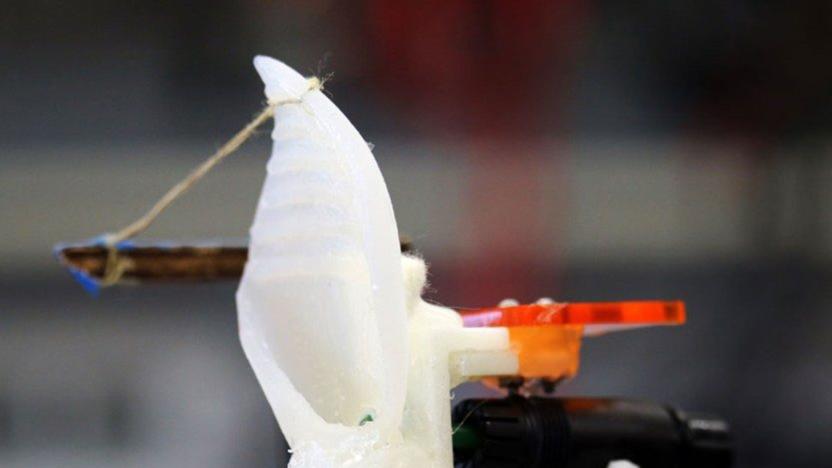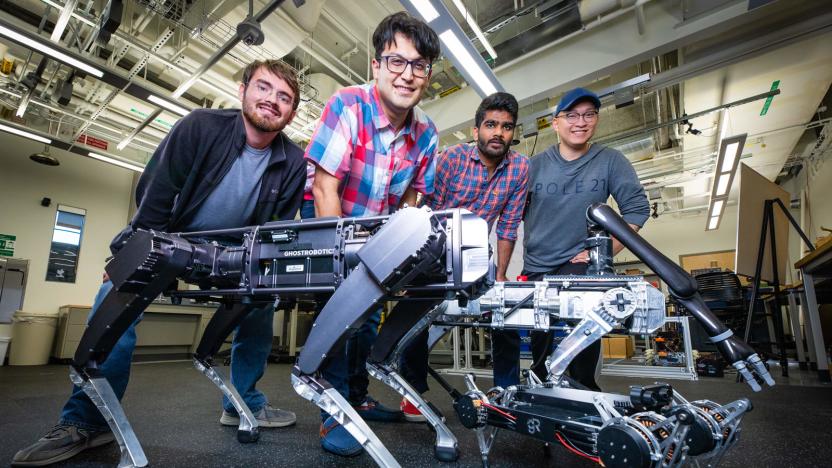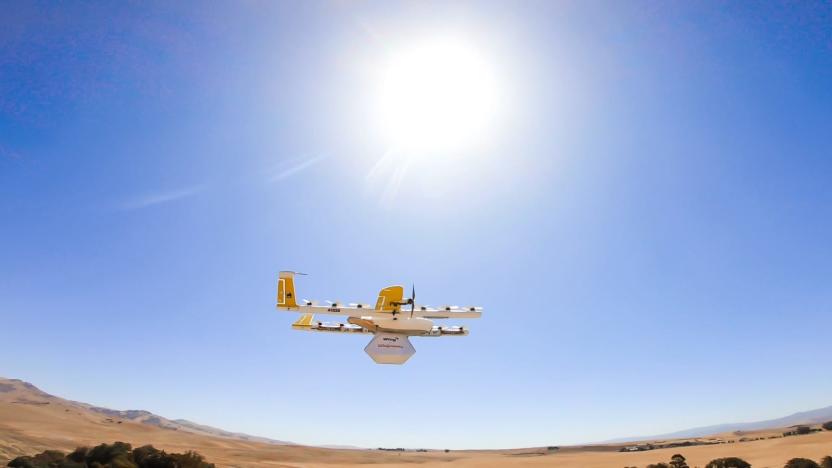Virginia Tech
Latest

Sound location inspired by bat ears could help robots navigate outdoors
Researchers have developed bat-inspired, AI-guided sound location that could help robots navigate outside.

Algorithms help robot dogs trot more like real animals
Robot dogs can move efficiently, but not all that naturally -- and no, twerking doesn't count. Virginia Tech researchers think they can do better. They're developing a combination of algorithms and sensors that help robots move with gaits more like those of real animals. The system mimics the behavior of vertebrates, whose balance control comes largely from oscillating neurons in the spinal cord, using a combination of encoder sensors (to read relative positions for joints) and inertial measurement units (to measure the body's orientation relative to the ground). The result is a mechanical canine that can walk, run and trot with more grace and speed than usual.

Alphabet’s Wing drones will soon deliver FedEx and Walgreens packages
This fall, Alphabet's drone delivery arm Wing will begin delivering goods for FedEx Express, Walgreens and a small retailer. The pilot program will be based in Christiansburg, Virginia, and it's meant to prove that Wing's drones are ready to deliver health care products, fill last-mile delivery needs and give local retailers a boost.

Robot bears are coming for your grandparents
Not content to simply blame millennials for killing practically everything, baby boomers are now expecting the younger generations to care for them in their agedness. The nerve. Indeed, some 13 percent of the American population is now 65 or older, though a recent report from the Pew Research Center suggests that figure will nearly double by midcentury. Given that the current annual median price of a nursing-home room is around $92,000 (and rising), and because we can't just up and dump a quarter of America at the Springfield Retirement Castle, robots will have to start lending elderly folks a hand. Because if there's anybody who inherently trusts new and confusing technologies, it's the olds.

ICYMI: Skydiving from drones while Lowe's exoskeleton does heavy lifting
Today on In Case You Missed It: Latvian UAV company, Aerones, which specializes in heavy-lift drones, has made publicity stunts an annual tradition and this year is no different. They perched a man atop a 330 meter electrical tower, then sent their 28-rotor drone up to pick him up, then release him to gently parachute back to the ground. It's the future of commuting. We also take a look at a new, unpowered exoskeleton that Lowe's home improvement and Virginia Tech have developed. It utilizes carbon fiber rods situated around the wearer's legs that flex as the user bends over bend and spring back once they stand back up. It makes picking up heavy items a breeze and has been well-received by store employees during recent trial runs. As always, please share any interesting tech or science videos you find by using the #ICYMI hashtag on Twitter for @Terrortola.

LTE: fast, global, silenced by a $650 radio jammer
Oh gosh, we haven't been so panicked since our phones were hypothetically possessed by demons. And come to think of it, this is theoretically far, far worse. A research group at Virginia Tech is claiming that, due to the particular way 4G data is transmitted, an LTE base station can be sabotaged using lightweight equipment that costs as little as $650. Such a thing is possible because, unlike 2G and 3G, LTE depends on control instructions that occupy only a tiny fraction of the total signal -- and details of those specific frequencies have been openly published. According to the research group's director, Jeff Reed, a single malicious operative with a hot briefcase and a bit of know-how could take down "miles of LTE signals." If the attacker splashed out on an amplifier, they could cut off reception for thousands of people across a whole city or region. Reed stresses that there are no known instances of this happening yet, but also warns that he can see no "mitigation strategies" that can "cover it all." Let us pray that humanity's characteristic inability to agree on anything -- including a universal LTE standard -- will be our salvation.

Robot jellyfish feeds on its surroundings, looks for a job in underwater surveillance
We've seen plenty of robots inspired by nature, but this robot jellyfish developed by researchers from University of Texas at Dallas and Virginia Tech goes one big step beyond mimicking a jellyfish's movements. It's powered by hydrogen, which means that it could potentially stay underwater for prolonged periods of time and constantly refuel itself from the water around it. That, the researchers say, could make it ideal for underwater surveillance or search and rescue operations, but they still have a fair bit of work to do before that happens -- their next step is to increase its maneuverability. Head on past the break to check it out in its current state.

SAFFiR: the autonomous, firefighting humanoid robot
It took six years, but at long last, Anna Konda has a formidable firefighting partner. SAFFiR, also known as the Shipboard Autonomous Firefighting Robot, is being shaped by scientists at the Naval Research Laboratory. As the story goes, it's a humanoid robot that's being engineered to "move autonomously throughout the ship, interact with people, and fight fires, handling many of the dangerous firefighting tasks that are normally performed by humans." Outside of being stoic (and brawny) from tip to tip, it's also outfitted with multi-modal sensor technology for advanced navigation and a sensor suite that includes a camera, gas sensor, and stereo IR camera to enable it to see through smoke. We're told that its internal batteries can keep it cranking for a solid half-hour, while being capable of manipulating fire suppressors and throwing propelled extinguishing agent technology (PEAT) grenades. Wilder still, it'll be able to balance in "sea conditions," making it perfect for killing flames while onboard a ship. Of course, it's also being tweaked to work with a robotic team, giving it undercover powers to eventually turn the flames on the folks that created it. Paranoid? Maybe. But who are we to be too careful?Update: Turns out, the same Dr. Hong that we had on The Engadget Show is responsible for this guy as well. It's the next step in evolution of the CHARLI humanoid, and the two photos seen after the break are credited to RoMeLa: Robotics & Mechanisms Laboratory, Virginia Tech.

VT nears completion of HokieSpeed, world's 96th most powerful supercomputer
If basking in the presence of a powerful supercomputer is on your list of "must-haves" when selecting a proper university, then you may wish to fire off an admissions application to the Hokies at Virginia Tech. The school's HokieSpeed system is now in its final stages of testing, which combines 209 separate computers, each powered by dual six-core Xeon E5645 CPUs and two NVIDIA M2050 / C2050 448-core GPUs, with a single-precision peak processing capability of 455 teraflops. To put things in perspective, HokieSpeed is now the 96th most powerful computer in the world, and yet it was built for merely $1.4 million in loose change -- the majority of which came from a National Science Foundation grant. As a further claim to fame, HokieSpeed is the 11th most energy-efficient supercomputer in the world. Coming soon, the system will drive a 14-foot wide by four-foot tall visualization wall, which is to consist of eight 46-inch Samsung 3D televisions humming in unison. After all, with virtually limitless potential, these scientists will need a fitting backdrop for all those Skyrim sessions. The full PR follows the break, complete with commentary from the system's mastermind, Professor Wu Feng.

DARwin-OP, CHARLI-2 humanoids make history at RoboCup 2011, 'U-S-A!' chants ensue (video)
While most American sports fans were busy celebrating a World Cup victory over Brazil this weekend, an indubitably more compelling soccer tournament was drawing to a close in Istanbul -- site of RoboCup 2011. Virginia Tech's Team DARwin made history at this year's event, becoming the first US squad to bring home top honors in both the Kid Size and Adult Size competitions. The petite DARwin-OP humanoid danced circles around the lightweight class, while the five-foot CHARLI-2 demoralized Robo Erectus in the big boys' final with a last-minute penalty kick. In its international debut, the CHARLI-2 (pictured, in a moment of Zen, on the right) also earned the vaunted Louis Vuitton Humanoid Cup, ending a nine-year period dominated by teams from Germany and Japan. These programmed Peles may not the most graceful of strikers, but RoboCup organizers remain convinced that autonomous bots will be able to compete with human athletes by 2050 -- which might just give us enough time to develop a taste for soccer. Dribble past the break to see Team DARwin in action, along with an extra clip from the BBC.

Robot hand hits 20WPM, nearly ready to embrace infinite monkey theorem
Robot hands have been grabbing, crushing, drawing and otherwise actuating for years, but have you ever seen one properly type? That's the primary purpose of a new Virginia Tech design. Engineers built this Dexterous Anthropomorphic Robotic Typing (DART) hand to mimic the real deal as best they could, down to individually-actuating three-segment digits and 110 degrees of wrist rotation in a package the size of a real human arm. Using a total of 19 servo motors and high tensile strength wire for the tendons, they managed to create a single mechanical paw that can achieve an estimated 20 words per minute while typing. Next, they plan to cover it in silicone skin and add piezoelectric sensors to provide tactile feedback. Imagine that: the next time a secret family member severs your arm with a focused plasma beam, you'll know where to go for replacement. Find a quick video and the full scientific paper at the links below.

Hokies give (tactile) sight to the blind so they can drive, no word on turning water into wine
Daytona International Speedway is synonymous with speed, auto racing, and . . . blind people? Virginia Tech's Robotics and Mechanisms Laboratory (RoMeLa), along with the National Federation of the Blind (NFB), recently debuted its sight-optional and street-legal SUV at the famed racetrack. Dr. Dennis Hong and his students first let blind folks drive a dune buggy without the help of a sighted copilot in 2009 -- as a first step to achieving the goal of a street-legal SUV for the sightless crowd. The SUV in question was designed for the NFB's Blind Driver Challenge, and is equipped with a drive-by-wire system -- also seen in the RoMeLa autonomous vehicle -- that was modified for use with RoMeLa's SpeedStrip and DriveGrip tactile interface technology. It works by using a laser rangefinder to map the surrounding area, relaying information for acceleration and braking to the driver by rumbling the SpeedStrip seat, and passing along turning info through vibrations in the DriveGrip gloves. The system was not developed solely for the purpose of getting blind drivers on the road, however, as Virginia Tech suggests that its technology could also be used in gaming applications. We're not quite ready to see blind drivers on actual roads just yet, but why shouldn't our sight-impaired friends get to enjoy Gran Turismo 5 with the rest of us? Video's after the break.

ESPN 3D review: college football kickoff
The 2009 BCS National Championship game showed us the potential of 3D sports broadcasts but now it's 2010 so while Sam Bradford and Tim Tebow have taken their game to the NFL, ESPN 3D has made it a reality for viewers at home. Last night's Boise St./Virginia Tech matchup was the first of 13 the network plans to air including the next BCS Championship game so we didn't waste any time plugging in a 3DTV and taking a look. Check after the break for our impressions and a bit more explanation on 3D technology (Still not up to speed? Check out our post-CES breakdown of 3D tech for the home right here.)

Virginia Tech's HokieSpeed supercomputer to rely on CPU and GPU synergies
Virginia Tech's no stranger to housing supercomputers -- those folks strung together 324 Mac Pros back in 2008 just for kicks, giggles and "research" -- but their latest computing monolith is quite the shift from the ordinary. A cool $2 million is floating over to Blacksburg in order to create HokieSpeed, a "versatile new supercomputing instrument" that'll soon be primed and ready to handle not just one or two tasks, but a variety of disciplines. Wu Feng, associate professor of computer science at the university, calls this magnificent monster a "new heterogeneous supercomputing instrument based on a combination of central processing units (CPUs) and graphical processing units (GPUs)," with expected performance to be orders of magnitude higher than their previous claim to fame, System X. One of its first assignments? To give end users the ability "to perform in-situ visualization for rapid visual information synthesis and analysis," and during the late hours, hosts a campus-wide Quake deathmatch. Just kidding on that last bit... maybe.

ESPN 3D schedules 13 college football broadcasts this season; Va. Tech / Boise St. is first
After unveiling the standard college football schedule, ESPN has seen fit to reveal the first three of the 13 games it plans to broadcast in 3D this season. Boise State will face Virginia Tech on September 6, a Monday night, while Ohio State and Miami will do battle September 11, before Clemson and Auburn have their ACC/SEC grudge match September 18. The plan is to have a college football game on ESPN 3D "almost" every week of the season, with the last being the BCS National Championship game January 10. Announcements regarding NBA, college basketball and Winter X Games 15 scheduling are on deck, but this weekend it's all about the Summer X Games 16.

Marines field autonomous support vehicles based on winning robot design (video)
Since their third-place finish in the 2007 DARPA Urban Challenge, TORC Technology's had quite a climb -- the company founded by Virginia Tech graduates has since provided IED-scouting Humvee kits to the US Military, and a vehicle for the blind uses the drive-by-wire platform that they designed. Now, the Marines are testing a TORC kit called the Ground Unmanned Support Surrogate (GUSS), which autonomously navigate off-road terrain. Designed to accompany ground troops, the four prototypes only move at 5 MPH, but carry up to 1800 pounds, and can automatically follow troops (or other GUSS) at a distance while shouldering their loads. A one pound transmitter -- the WaySight -- can show the GUSS where to go, or optionally enable direct control for soldiers who prefer things the old-fashioned way. Personally, we love the smell of autonomy in the morning, don't you? See it in action after the break.

Prototype car with tactile feedback challenges the blind to drive (update)
We can already imagine just what you're thinking -- the blind have no place behind the wheel, right? As it turns out, though, cars can steer themselves these days, so there technically no reason why (save a few laws) a computer-assisted blind person couldn't drive. Virginia Tech's RoMeLa successfully tested a laser-guided dirt buggy last year (see above), and teaming with the National Federation of the Blind this week, it intends to demonstrate a pair of full-sized augmented SUVs next year. In January 2011, the Daytona racetrack will play host to two heavily customized Ford Escape, filled with "nonvisual interfaces" like a vibrating vest and gloves (dubbed DriveGrip), a steering wheel that provides audio cues on when to turn, and a tablet device covered with tiny holes (called AirPix) that represents the road and obstacles around the vehicle with jets of compressed air. Even with all those gizmos, we understand if you still might not want your neighbors barreling down the street, but let's face it -- plenty of us sighted folks are just as visually impaired. Video and full press release after the break. Update: Dr. Dennis Hong of RoMeLa just informed us that though the auditory steering wheel was part of the laser-guided buggy, it won't appear on the Ford Escape. He also relates that letting the blind drive is merely a short-term goal -- the big picture here is to develop new interfaces for the blind, and safer transportation technology for all.

RoboCup Soccer 2010 finals show impressive realism by feigning injuries (video)
The World Cup may still be ongoing (despite what the US, England, and a handful of others may think), but the RoboCup 2010 in Singapore has just closed shop with an edge-of-your-seat display of autonomous action. The final game came down to two German teams, the Darmstadt Dribblers and the FUmanoids. As seen at numerous points, both android teams have even learned the ancient art of diving, toeing the uncanny valley a little to close for comfort. Video after the break -- we won't to spoil the ending, so let's just say Germany won by a sizable margin. If fierce competition isn't your cup of tea, we've also got footage of DARwIn-LC, a low cost (hence the name) humanoid from our friends at Virginia Tech's RoMeLa. These adorable little guys cost about $2,500 apiece and will be going out to 11 of VT's partner universities. Update: Dr. Dennis Hong himself sent us a few clarifications. The DARwIn-LC is a collaboration between RoMeLa and the company Robotis. No price has been disclosed, but the $2,500 is incorrect. Additionally, the robot is being planned as a "true 'open platform.'" In Hong's words, "we are "planning" to post all CAD drawings, fabrication and assembly manuals, and also the basic software on-line for free. Thus any one with certain equipment, budget, and skills will be able to make one them selves - or purchase the entire thing or parts from Robotis. We want to form a community of DARwIn-LC users to share new ideas for improvement, hack it, etc. and use the robot for research, education, outreach, and of course, an easy entry point for the RoboCup humanoid division." Also hit up More Coverage to see how RoMeLa fared at RoboCup! [Thanks, Stefan]

Virginia Tech researchers reveal full-sized CHARLI-L humanoid robot (update: video!)
Dr. Dennis Hong was kind enough to give us a glimpse the CHARLI robot on The Engadget Show this weekend -- or its leg, anyway -- but he and his students have just now finally revealed the full-sized bot that's been described as a "robot teenager." As we'd heard, CHARLI is actually a series of robots that initially consists of the 5-foot tall CHARLI-L (or lightweight, pictured above), and the forthcoming CHARLI-H (or heavy), both of which are completely autonomous, with a full range of movements and gestures thanks to a series of pulleys, springs, carbon fiber rods, and actuators (not to mention some slightly more mysterious AI). What's more, while CHARLI-L is currently restricted to walking on flat surfaces, CHARLI-H promises to be able to walk on the uneven ground around the Virginia Tech campus, and eventually even be able to "run, jump, kick, open doors, pick up objects, and do just about anything a real person can do." Unfortunately, there doesn't seem to be any video of CHARLI-L in action just yet, and it is still somewhat of a work in progress -- the researchers say it will be able to speak soon, and they're also busily working to improve its soccer skills in time for this year's RoboCup. [Thanks, Kyle] Update: Video is now after the break!

Amoeba-inspired ChIMERA robot slithers on video
Virginia Tech's RoMeLa Lab has done more than its fair share to further the development of our future robot overlords. Now, in a recent TED talk, Dr. Dennis Hong brings us up to date on some of the creepier candidates for world domination, including the spider-like STRiDER and the amoeboid ChIMERA (Chemically Induced Motion Everting Robotic Amoeba). The latter achieves locomotion by the movement of its silicone skin, squeezes through spaces half its diameter, and travels up to half a meter per second. The good doctor is tight-lipped on much of the device's specifics, but among options being explored for powering the thing are chemical actuation, electroactive polymers, and air-driven tubes. Check out the team's work in the video after the break. [Thanks, Travis]









